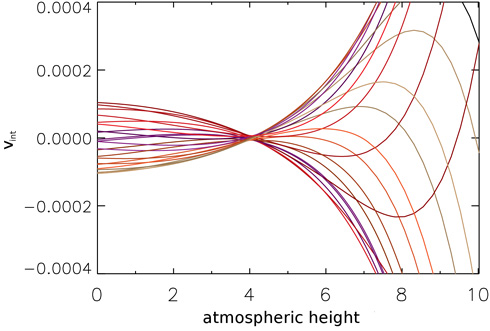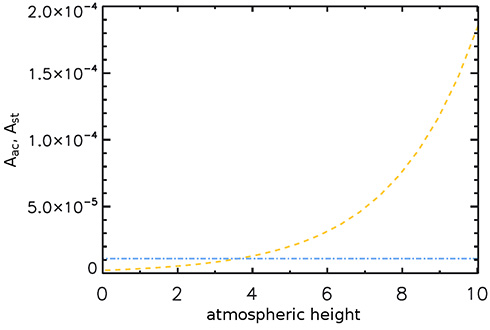 CAUP Researchers: Joana C. A. M. Sousa, Margarida S. Cunha On the understanding of pulsations in the atmosphere of roAp stars: phase diversity and false nodes, Studies based on high-resolution spectroscopic data of rapidly oscillating Ap (roAp) stars show a surprising diversity of pulsation behaviour in the atmospheric layers, pointing, in particular, to the co-existence of running and standing waves. The correct interpretation of these data requires a careful modelling of pulsations in these magnetic stars. In light of this, in this work we present a theoretical analysis of pulsations in roAp stars, taking into account the direct influence of the magnetic field. We derive approximate analytical solutions for the displacement components parallel and perpendicular to the direction of the magnetic field, that are appropriate to the outermost layers. From these, we determine the expression for the theoretical radial velocity for an observer at a general position, and compute the corresponding pulsation amplitude and phase as a function of height in the atmosphere. We show that the integral for the radial velocity has contributions from three different types of wave solutions, namely running waves, evanescent waves and standing waves of nearly constant amplitude. We then consider a number of case studies to illustrate the origin of the different pulsational behaviour that is found in the observations. Concerning pulsation amplitude, we find that it generally increases with atmospheric height. Pulsation phase, however, shows a diversity of behaviours, including phases that are constant, increasing or decreasing with atmospheric height. Finally, we show that there are situations in which the pulsation amplitude goes through a zero, accompanied by a phase jumps of π, and argue that such behaviour does not correspond to a pulsation node in the outermost layers of the star, but rather to a visual effect, resulting from the observers inability to resolve the stellar surface.
Peculiar stars belonging to the A spectral class (known as Ap stars) are characterized by increased abundances of some heavy elements, including high abundances of some rare-earth elements, as well as strong magnetic fields. A subset of such stars, identified as rapidly oscillating Ap stars (roAp), are furthermore characterized by presenting oscillations with periods of 5-21 min and amplitudes of 0.5-5 kms-1. Thanks to their physical characteristics, and with a few tens of roAp stars already known, researchers have been using them as probes to study the interaction between acoustic modes and strong, large-scale magnetic fields. Particularly, spectroscopic observations conducted during the last few years have shown that different spectral lines reveal considerably different behaviors of their oscillation modes, especially those lines with origin in the upper layers of the atmosphere. Furthermore, phase shifts are often detected between different lines, as well as amplitude variations with depth. Thus, the detection of pulsation zeros in the amplitude diagram concomitantly with phase shifts has led scientists to interpret them as evidence for the existence of pulsation nodes. With the work leading to this highlighted paper, the CAUP researchers aimed at studying the relations between the observed variable phases and amplitudes and the underlying physical conditions of the star. A complete understanding of roAp oscillations requires the probing of a large parameter space, which will be done in a subsequent paper. In this paper, the researchers considered a number of illustrative examples of the studied physical processes. For this, the researchers developed an analytical model which was used to study the propagation of magnetoacoustic waves in the upper atmosphere of these stars, for several different sets of parameters. Several layers were considered, according to the relative importance of the magnetic and gas pressure, and focused in the outer atmospheric region, where the plasma, magnetically-dominated, is assumed to be isothermal. In this layer, where relevant spectral lines of rare-earth elements form, the magnetoacoustic wave is decoupled into a magnetic and an acoustic wave. The results obtained show that no real pulsation nodes exist in the upper atmospheric region; instead, only fake nodes may exist, as the one depicted in Fig. 1 and Fig. 2, and these may be responsible by some of the phase shifts and amplitude zeros observed in rare-earth elements lines. However, real nodes may still be present at the photosphere level. Moreover, the waves’ amplitudes were found to present a general trend of increasing with atmospheric height, as expected. On the other hand, this work shows that pulsation phases may not be easily used to reconstruct the underlying geometrical properties of the pulsation, thus, limiting their potential for inferring about localized atmospheric conditions in these stars.
|























